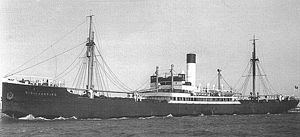Name Rio de Janeiro Owner Hamburg Süd Out of service 8 April 1940 Length 122 m Builder Bremer Vulkan | Namesake Rio de Janeiro Operator Kriegsmarine Launched 3 April 1914 Beam 17 m | |
 | ||
Port of registry Stettin, Germany (1914–33)
Stettin (1933–40) | ||
MS Rio de Janeiro was a German steam ship and a cargo ship, owned by the shipping company Hamburg Süd and home ported in Stettin. She was launched on 3 April 1914 as Santa Ines and later renamed Rio de Janeiro. Before World War II she carried passengers and freight between Germany and South America.
Contents
She was requisitioned by Nazi Germany's Kriegsmarine for transportation of troops on 7 March 1940, before Operation Weserübung, the invasion of Norway and Denmark, began on 9 April 1940.
Invasion of Norway
The secret plan for the ship was to arrive at Bergen right after German troops had captured the town. On board Rio de Janeiro there were a total of 50 crew and 330 soldiers. Her cargo consisted of six 2 cm FlaK 30 and four 10.5 cm FlaK 38 anti-aircraft guns, 73 horses, 71 vehicles and 292 tons of provisions, animal feed, fuel and ammunition.
Sinking
The ship left Stettin on 6 April 1940 at 3 AM. Two days later, at 11.15, only hours before the attack on Norway began, a surfaced submarine was sighted off Lillesand. At first it was thought to be a German submarine, but it turned out to be the Polish submarine ORP Orzeł, serving under British command. It had 85 A written on the tower. The submarine signalled for Rio de Janeiro to stop, and the order was followed. Captain Grudzinski, of the Polish Navy, then ordered the ship to surrender or it would be sunk, but nothing happened. The Polish submarine then torpedoed the ship, and she took in water and began sinking. The crew and soldiers on board began to jump into the sea. At 12.00, an aircraft from the Royal Norwegian Navy Air Service started circling around the sinking ship. At 12.50 the submarine torpedoed the ship a second time, from a submerged position. The torpedo hit the ammunition depot, which caused an explosion. About 180 survived the sinking, and were rescued from the sea and brought by local vessels to Lillesand and Kristiansand; roughly 200 died.
Norwegian authorities notified
Norwegian officials were told by survivors that the ship's destination had been Bergen. The fact that there were horses on board and that many of the dead and survivors were wearing military uniforms, led to alerting of the central authorities. However, the government did not realize that a German invasion was imminent.
The wreck
The exact location of the wreck of Rio de Janeiro was unknown for many years. Fishermen over the years caught parts from the wreck in their fishing nets in this area, and the Royal Norwegian Navy attempted to locate the wreck.
In June 2015, more than 75 years after the torpedoing, the wreck was finally located by a Norwegian diving company at about 135 metres (443 ft) depth off Lillesand.
